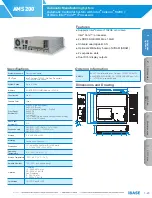
I.
INTRODUCTION
The BC145 Signal Isolator is used to isolate, amplify and condition DC voltage and current sig-
nals from any source (motors, tachs and transducers) which will provide most adjustable speed
motor controls with a voltage following input. The maximum output voltage of the isolator is 10
volts, which is a linear function of the input signal.
The BC145 is versatile since it can accommodate a wide range of input voltages (0 - 25*, 0 -
120 and 0 - 550V DC) and, in addition, a wide range of input current signals (4 - 20 mA, 10 -
50 mA and 1 - 5 mA). The Voltage/Current (“VLT/CUR”) jumper is used to change the
BC145 from a voltage to current input.
BC145 is a unipolar input, providing 0 – 10V input. For Regenerative Drives with bipolar ±10V
input, other Signal Isolators are available.
A built-in power supply enables the BC145 to be controlled with a 5KΩ remote potentiometer
(connect potentiometer to terminals “P1,” “5” and “6” – see page 9). The potentiometer can
also be wired for Auto/Manual Operation.
*The input range of 0 - 25V is the maximum voltage that can be applied to terminals “5” and
“6”. The minimum input voltage is 0 - 5 volts, which can achieve an output voltage of 0 - 10
volts. The unit is factory calibrated so that a 0 - 10V DC input yields a 0 - 10V DC output.
II.
MOUNTING
Mount the Signal Isolator using (4) 6-32 screws (not included). Use the Control Layout and
Mechanical Specifications drawing on page 3 to locate the mounting holes. The unit is
designed to be mounted in any position providing its components do not come in contact with
grounded or live wiring.
2
































